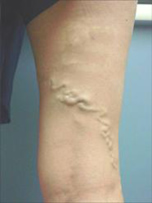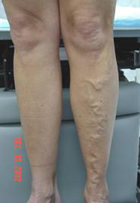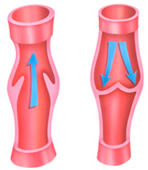
University Vascular Associates
Marina Laser Vein Center
Marina Laser Vein Center
4560 Admiralty Way - Suite 356
Marina Del Rey, CA 90292
Call us at: (310) 823-7314
Welcome to Marina Laser Vein Center! Our fellowship-trained vascular surgeons utilize the most advanced minimally invasive treatment of vein disease.
We look forward to meeting you and providing you with the best possible care!
Varicose veins are formed as a result of venous insufficiency, a condition caused from incompetent valves. They can originate from several different systems including the greater saphenous vein, the short saphenous vein, the anterior lateral branch and the thigh extension branch. Varicose veins appear as twisted, enlarged veins that lie close to the surface of the skin. The goal of the endovenous laser treatment is to eliminate the defective veins, forcing blood to return to the heart through the deep vein system.



Symptoms
Symptoms of varicose veins may include the following:
Contributing factors include:
- Pain, aching, or burning in the legs
- Edema in the legs or ankles
- Leg cramps or sores
- Itching of the skin around the vein
- Open wounds such as skin ulcers around the ankle
Incidence and Causes
Nearly 70% of all women and 30% of men will develop some type of venous disorder due to insufficient blood circulation. Although the exact cause is unknown, there are many that contribute to the weakening of the vein walls including:
- Heredity
- Pregnancy
- Hormonal changes
- Obesity
- Standing or sitting for long periods of times
- Advancing age
- Injury
Anatomy
Since humans walk upright, our leg veins contain valves that normally allow one-way blood flow from the feet up to the heart. They close and prevent backward blood flow when resting in the standing position. When the valves fail, there is backward blood flow (venous “insufficiency” or “reflux”) that results in very high venous pressure. Because veins have very thin walls, this high pressure causes significant stretching and elongation – resulting in the formation of varicose and spider veins.

Procedure
To effectively diagnose a patient showing symptoms of varicose veins, a physician will conduct a duplex ultrasound to determine if truncal insufficiency is present. Once diagnosed, the physician will decide if endovenous laser treatment is an appropriate solution.The endovenous laser treatment is a 30-45 minute in-office procedure with no down time or scarring. The physician will determine the particular treatment procedure that is most appropriate for the patient. Generally described, the skin is numbed before treatment. The vein is accessed percutaneously and an introducer is inserted into the vein. The laser filament is inserted through the introducer. Once inside the vein, the placement of the laser filament is verified using ultrasound and by visualizing the aiming beam. The laser is then slowly withdrawn as it emits energy. This laser energy seals the vein shut.
Post Procedure Protocol
Once the procedure is complete, a compression dressing is placed on the treated leg for 2 days followed by 1 week of compression stockings. Under normal conditions the patient may return to work the following day.The following are common physician recommendations:
- Wear compression stockings for a period of one week all the time, then 3 more weeks during the day
- Abstain from high impact activities such as running or step aerobics for a period of 3 weeks
- Hormonal changes
- Walking is encouraged, as it will aid in the healing process.
A repeat ultrasound will be done in 3-7 days to check the deep leg veins, and again in 4 weeks to ensure that the treated veins are sealed. Occasionally, a treated vein will reopen, requiring either injection of foam sclerotherapy or repeat laser treatment. 98% of treated veins are sealed shut at 1-year follow-up.
As with any procedure, some mild side-effects might occur. You may experience a slight redness to your skin tone in the treated area, which will fade away within a few days. You might also notice a slight swelling in the treated area.
Alternative Treatment Options
Surgical Treatments
Microphlebectomy is often performed in the office as an adjunct to laser closure of the saphenous or other malfunctioning truncal veins. Under local anesthesia, small 2-3 mm incisions are made, and the underlying varicose veins are removed. No suture is needed to close the incisions, and the scarring is very minimal to none. The leg is wrapped with dressings for 2 days and then compression stockings are worn as above.
High ligation and stripping is performed under general anesthesia, regional or local anesthesia. An incision is made in the groin and the saphenous vein is ligated. A small stripper is placed in the distal vein and exits at the knee level. The vein is attached to the stripper and the vein is pulled out. There is a high incidence of recurrence and a high incidence of neovascularity (growth of new veins.) Due to the surgical nature of this procedure, down time can vary from two to three weeks, and is more painful than other non-invasive alternatives. This procedure is being done less and less frequently, and will likely soon be of historical interest only.


